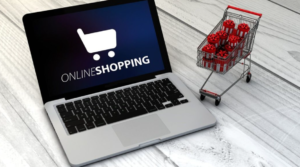
Digital marketing for e-commerce – where to start and what to know before you begin? In this article, we’ll tell you about the different ways you can start to increase your online sales and what you need to take into account to make your digital marketing as profitable as possible.
If you want to avoid the unfortunately common scenario where already high sales continue to rise while sales fall and growth slows or stagnates, then keep reading.
We’ve put together the most effective marketing channels and the most critical tips for truly effective digital marketing for e-commerce!
Digital marketing starts with your online store
Before you start digital marketing your online store, you need to understand and internalise one thing: all sales and marketing starts with your online store.
The goal of your online store is to generate a conversion (a sale or other targeted transaction), which for you may mean making a purchase or joining an email list. Your store’s main task is to generate this transaction.
Other channels will never sell on behalf of your online store, they can only increase visibility and traffic to it. Therefore, your online store is your main sales channel and all marketing should start there.
Digital marketing channels such as soma and Google are designed to build brand awareness and bring people to the online store where the actual buying takes place. If visitors to your online store are not convinced by what they see, sales will not be made. No matter how many people you bring into your store from any other channel.
For your online store to be most effective in generating conversions, or sales, it needs to be implemented in a way that both meets your potential customer’s needs and drives your business goals forward.
This is why digital marketing for e-commerce should focus from the outset on the store’s conversion rate, i.e. its ability to persuade visitors to complete a purchase or other desired action.
The structure, navigation, layout, elements and content of an online store, for example, form a whole that either works together to convert visitors into paying customers or does not. If your online store is not designed with conversions as its main objective, it is unlikely to sell now or when people are brought in from other channels.
Advertising alone is hardly ever enough to generate real sustainable sales growth, which is why your main marketing channel will always be the online store itself, where your primary focus should be.
Improving conversion rates is the first and most important part of digital marketing for e-commerce
To achieve long-term results, you need to work on the conversion rate of your online store. It is only worthwhile to start advertising when your online store can effectively convert inbound traffic into customers.
The success of digital marketing for your online store is guaranteed when it is first optimised for sales. Sales can be increased by making the online store as user-friendly as possible and in line with the company’s objectives.
In practice, during conversion optimisation, the user experience of the online store is improved, while visitors are guided and helped towards the desired actions. Such as making a purchase and paying.
The measures that go into improving conversions and sales in an online store will vary depending on the state of the store.
In general, the most critical issues that need to be addressed in a poorly selling online store are slow loading times, an opaque design and poor usability. In addition to these, there may be problems with the store’s appearance, code, elements used and content, among other things. Shops are also often overloaded by unnecessary and incorrect add-ons.
A/B testing can help to identify the issues that need to be addressed in the online store.
So there can be many different types of errors and it is often difficult to find all the mistakes if you don’t know what you are looking for. Some good guides can be found on Google, but without experience it can frankly be challenging to successfully perform conversion optimisation.
If you are just starting out as an online merchant and want to have a selling online store right away, we recommend turning to a professional instead of doing it yourself. At Growly, conversion optimization is always included in the price of implementing an effective online store.
Conversion optimisation can also be carried out on an existing online store or one that is under construction. At this point, however, it is important to understand that if the online store has not been implemented in accordance with industry best practices, a significant improvement in conversion performance may require a complete rebuild of the store.
Nevertheless, a complete ecommerce overhaul often proves to be a cheaper and more efficient option than optimising an old online store.
The most effective digital marketing channels for e-commerce and how to choose them correctly
Assuming that your online store is already conversion optimised and tested to convert effectively, it’s time to decide which marketing channels you will use to drive traffic to your online store.
The appropriate digital marketing channels should be chosen according to your target audience and resources. As an online retailer, you obviously want to be everywhere where your potential customers spend most of their time. But if you don’t have the time and/or money to manage every potential marketing channel, it is not necessary or even worthwhile to be everywhere.
When resources are limited, as they are for many entrepreneurs, you’re much more likely to get something out of digital marketing for your e-commerce business when you’re not trying to be in as many places as possible at half speed.
So find one or a few suitable marketing channels that you have the time and budget for and start investing in them seriously.
There are many channels for digital marketing, but we have found search engine optimisation, Google advertising, social media advertising, content marketing and email marketing to be the most effective for online retailers.
Let’s go through them next.
1. SEO (Search Engine Optimisation)
Search engine optimisation, or SEO, refers to the various measures taken to increase the visibility and findability of an online store in search engines organically (naturally, by non-paid means).
There are many search engines, but the first choice for most people is Google. You can also consider using other search engines for your online store’s digital marketing, but for now we’ll focus on this search engine, by far the most popular.
Search engine optimisation is, of course, about getting to the top of the first organic search results.
SEO pays off because organic search results have been proven to get far more clicks than Google ads, and you don’t have to pay for them (clicks).
People simply trust natural search results more and the vast majority do not have the energy, bother or desire to click past the first page. This is reflected in the statistic that Google’s first page websites take up 95% of all traffic. The second and final pages of the website therefore receive a mere 5% of traffic.
The order of organic results, which search engine optimisation seeks to influence, matters. For example, the first natural search result gets 10 times more clicks than the tenth result.
No wonder, then, that many people choose to invest in search engine optimisation for their online marketing.
How is search engine optimisation done?
There are different types of search engine optimisation. There is external, internal and technical search engine optimisation, each of which consists of its own set of measures.
Some SEO, such as internal optimisation, is easier to implement if you first familiarise yourself with best and current practices in the field. This includes optimising the content of the site, such as texts, links and metadata.
External search engine optimisation includes links from other sites to your online store, which can be difficult to obtain without quality content and strong authority.
You can do search engine optimisation yourself in the beginning, if you are willing to do enough research and learn new things. But if you do it alone and without in-depth knowledge, you’re unlikely to get it right.
Indeed, the more competition for search rankings in your sector and the worse shape your online business is in, the more demanding it is to do search engine optimisation. If your online store is conversion-optimised, it will require a little less work from a search engine optimiser, and in this case, with little competition, it can be relatively easy to get your online store visible in search engines.
In more competitive areas, however, ranking high in search results and staying there requires much more, even if the shop is technically sound. In this case, you’ll get results faster and more confidently if you enlist the help of a professional for your online store’s digital marketing and search engine optimisation.
Search engine optimisation is also about keeping a constant eye on the performance of your online shop and quickly correcting any errors that are negatively affecting your search rankings.
This is where technical optimisation comes into play, involving many different measures relating to the functionality and structure of the online shop, most of which already require web development and coding skills, which can be found in the industry.
Search engine optimisation vs. conversion optimisation
To a certain extent, conversion optimisation and search engine optimisation involve similar measures. They are not exactly the same thing, as they have different objectives and require slightly different skills. However, when done correctly, search engine optimisation and conversion optimisation have a positive impact on each other.
While conversion optimisation measures often improve search engine visibility, search engine optimisation measures can equally increase conversions.
For example, improving the structure of an online store (conversion optimisation) not only appeals to people, but also to search engine bots and thus has a positive impact on search rankings (search engine optimisation).
On the other hand, blog content and meta descriptions displayed on Google (search engine optimisation), for example, can drive conversions.
In the world of e-commerce, there is therefore a kind of ‘catch-all’ effect. Hopefully, you too are beginning to understand why e-commerce implementation plays such a big role in the success of digital marketing.
2. Google Ads or search engine advertising
SEM, or keyword advertising, is one of the most commonly used and effective forms of Google advertising.
Google Ads, or keyword ads, are text ads that appear above the search engine’s organic results whenever a user enters your keywords, or possibly close versions of them, into Google’s search bar. Keyword advertising is therefore a way of promoting your online store and your products using the keywords you specify.
This allows you to reach potential customers at the very moment when they are actively searching for information about your products.
According to Semrush, the average person does 3-4 Google searches a day, which is a very high potential number for an advertiser.
With the right keywords and attractive text, keyword advertising is therefore a very cost-effective digital marketing tool for e-commerce and a quick way to increase sales.
For the online retailer, Google’s keyword advertising offers several advantages, the most important of which is the ability to reach targeted groups (ads can be targeted precisely by audience, for example by location, gender, age and interests), to fully manage the budget and to analyse and track results accurately using Google Analytics.
3. Display or banner advertising
Google’s Display banner advertising reaches an estimated 90% of internet users.
Google does this by using platforms other than the search engine itself to deliver display advertising: YouTube, Gmail, the Play Store, and a variety of collaborative websites and apps. There are only a few million of the latter in the network.
Display ads are great for reaching people who are not actively looking for a product, but who fit well with your target audience and your potential customer profile, i.e. who might well be interested in what you have to offer.
In a huge network, ads will appear at the top of the page you are browsing, on a page, or during a YouTube video, for example.
As a digital marketing tool for e-commerce, display advertising can be very effective as it offers a cost-effective way to reach a very wide audience.
However, before you start any kind of Google advertising, you need to be aware once again that the performance of your store will have a big impact on how much you have to pay for ads and how high you can get your ads to rank. It’s all in the mix, which is why before advertising on your online store you should have done conversion optimisation and at least basic search engine optimisation.
4. Soma advertising (including Facebook and Instagram)
You can generate a significant amount of traffic by promoting your online store on social media channels such as Instagram, Facebook, LinkedIn and Tiktoki. In addition to driving traffic, social media advertising is an effective way to increase brand awareness.
Since each social media channel and advertising on them works slightly differently, it’s worth diving deeper into your chosen platform or platforms before you start advertising. However, one thing to remember when advertising on any social media platform is that your ad must be of real quality and interest.
Simply advertising without thought or strategy will not lead to increased sales, and a poor or bland ad can even undermine trust in your brand.
Soma advertising also carries its own risks when used as the sole digital marketing tool for an online store.
In recent years, the cost of advertising has risen in line with increasing demand, and advertising prices can vary considerably depending on the competitive situation.
Soma ads may work well today, but the results they produce are generally not as stable as organic traffic. Things can also change quickly in a day if a sometili is accidentally shut down or hijacked.
While somemail advertising can be a very effective way of implementing digital marketing for an online store, it should not be used as a complete replacement for organic traffic, as natural traffic will always grow more steadily over time than paid traffic, and there is no need to keep paying for organic visibility and the clicks it generates.
For these reasons, somemarketing usually pays off best when combined with search engine optimisation and organic online and somesite content production.
In the meantime, we would like to remind you once again that no amount of traffic (purchased or organic) will produce sustainable results if the online store has not been fine-tuned before the advertising starts.
Since time and money are precious, and you will have to pay for every click whether your ad generates sales or not, it is worth having the groundwork done before you start investing in advertising properly.


